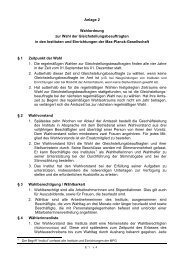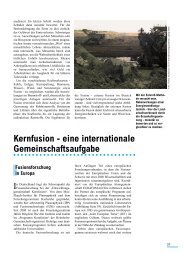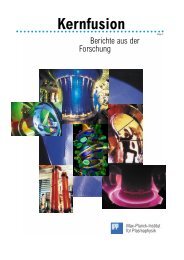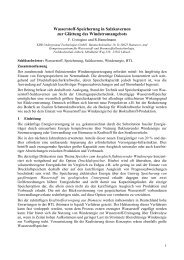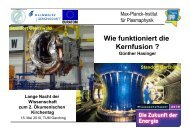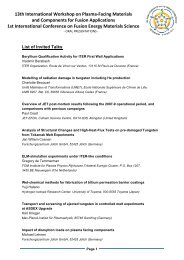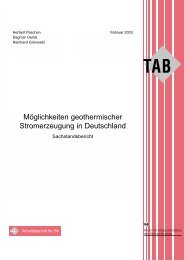IPP Annual Report 2007 - Max-Planck-Institut für Plasmaphysik ...
IPP Annual Report 2007 - Max-Planck-Institut für Plasmaphysik ...
IPP Annual Report 2007 - Max-Planck-Institut für Plasmaphysik ...
You also want an ePaper? Increase the reach of your titles
YUMPU automatically turns print PDFs into web optimized ePapers that Google loves.
will be later supplied from outside. The NBI ports as well as<br />
the port for the diagnostic injector need to be protected<br />
against energetic particles by graphite tiles right from the<br />
beginning on. Due to the spatial constraints these areas need<br />
a sophisticated design. Design studies for both areas have<br />
been started.<br />
3.5.4 Cryo-pumps<br />
Ten cryo-pumps are located behind the target plates and<br />
allow increasing the pumping capacity for hydrogen and<br />
deuterium up to 75 m 3 /s during high-density plasma discharges.<br />
The cryo-pumps are composed of a cryo-panel<br />
cooled with single phase helium, a Chevron baffle cooled with<br />
liquid nitrogen and an additional water cooled baffle. Fabrication<br />
of the cryo-pumps is well advanced (see figure 11).<br />
Figure 11: Main parts of a cryo-pump unit<br />
The cryo-pumps will be installed only after the first operation<br />
phase. Hence fabrication activities were slowed down<br />
and are now only continued in the Garching workshops on a<br />
fill in basis. According to the original design the two pumping<br />
units behind a divertor target would be integrated as one unit<br />
together with the interconnecting cryo-line during assembly<br />
of the plasma vessel. This would have allowed performing a<br />
cold leak-test of the whole unit outside W7-X before assembly.<br />
Since the pumping units shall now be assembled at a<br />
later stage the cryo-line must be separated to allow insertion<br />
of the units into the plasma vessel through a port opening<br />
and joining the cryo-line inside the plasma vessel.<br />
3.5.5 Control coils<br />
Ten control coils will be installed behind the baffle plates.<br />
These coils will be used to correct small field errors at the<br />
plasma edge, to optimize the position and extent of the islands<br />
and dynamically sweep the power across the target plate.<br />
Wendelstein 7-X<br />
37<br />
The coils are supplied by the company BNG. Each coil is<br />
made of eight turns of a hollow copper conductor and is<br />
water cooled. By the end of <strong>2007</strong> all ten coils have been<br />
manufactured and six coils have been tested and accepted<br />
(see figure 12). The first two coils have been delivered to<br />
Greifswald and will be used for assembly trials and a test of<br />
the power supply units.<br />
Figure 12: Functional test of a control coil with integrated current leads<br />
3.5.6 Supply lines inside the plasma vessel<br />
Cooling of the in-vessel components is provided from the<br />
main water system through 80 supply ports in the different<br />
W7-X modules. The interface between the supply lines and<br />
the cooling loops inside the plasma vessel is realised by<br />
plug-ins. The water cooling loops inside the plasma vessel<br />
comprise a very complex network with a total length of<br />
about 4000 m. Routing of the water pipes has to consider the<br />
3D-shape of the plasma vessel, pass around a high number<br />
of port openings for diagnostics and heating systems, take<br />
into account the restricted space behind the wall protection<br />
panels, and identify appropriate attachment points. In addition,<br />
the design of the cooling circuits has to consider many<br />
interfaces with the diagnostics and heating systems. The<br />
detail design of the pipe work is supported by manufacture<br />
and trial assembly of full-scale prototypes of the cooling<br />
loops. First prototype loops have been manufactured by <strong>IPP</strong>.<br />
Assembly trials are performed in a wooden mock-up of the<br />
plasma vessel which was moved from Greifswald to<br />
Garching.<br />
3.6 Refrigeration System<br />
The refrigeration system has an equivalent peak power of<br />
7 kW at 4.5 K to supply the magnet system the thermal<br />
shields, the current leads and the cryo-pumps with helium<br />
at different temperatures and pressures. Linde Kryotechnik<br />
AG is in charge of the delivery of the helium refrigerator.






